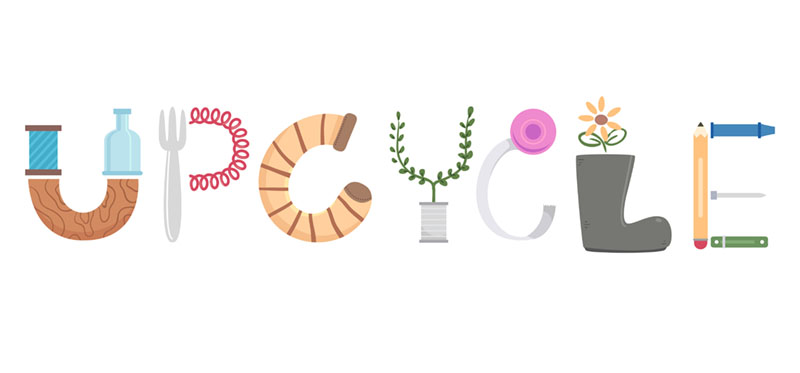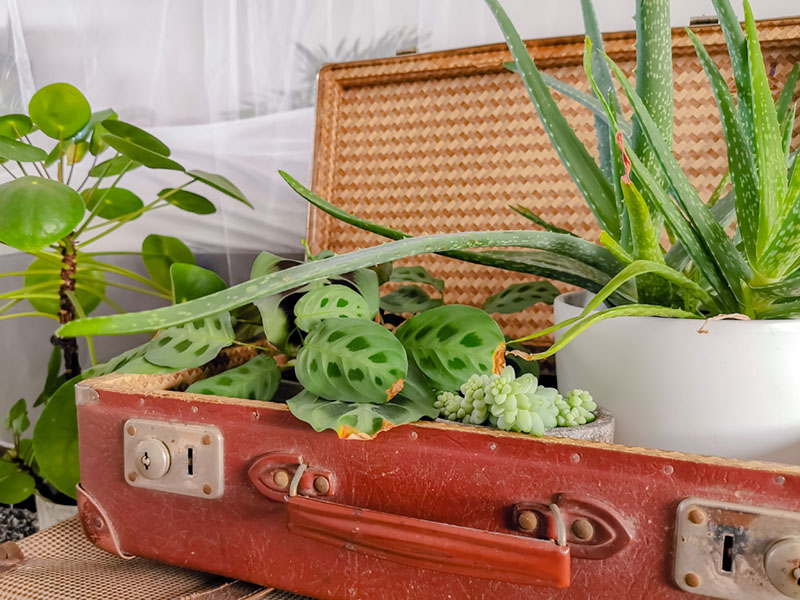Most of us are familiar with the three R’s: reduce, reuse, and recycle. But another word has made it into the vocabulary of many sustainability enthusiasts recently: upcycle. What exactly is upcycling and what’s the difference when it comes to upcycle vs recycle?
This article will answer those questions and remind you why we need to be doing a lot more of both of them.
Upcycle vs Recycle: What’s the Difference?
Let’s start out with a few definitions from one of the world’s largest recycling organizations, TerraCycle:
- “Recycling is the process of recovering material from waste and turning it into new products.”
- “Upcycling means to use a certain material again, but in a manner different than what it was originally intended for.”
Recycling Basics
When an item is recycled, it’s typically destroyed by a process like shredding, chopping, or melting before being re-reformed again into a new product.
In some cases, it may be downcycled, meaning that the recycled material has reduced functionality and quality than the original, pre-recycled material. An example of this is when a plastic laundry detergent jug gets recycled. It typically won’t be transformed into a new jug, but might instead become a thinner food container, before being downcycled again into something like a plastic bag.
It’s important to note that the downcycling process can only continue so long before the material is unsuitable for further recycling and instead will end up in a landfill.
While this isn’t necessarily the case for all recyclables (glass, aluminum, and paper have better fates), it’s the reality of plastic recycling. We’ll leave you with a final thought about recycling, which was published in a 2017 ScienceAdvances study:
“Recycling delays, rather than avoids, final disposal. It reduces future plastic waste generation only if it displaces primary plastic production; however, because of its counterfactual nature, this displacement is extremely difficult to establish.”
According to estimates included in the study, just 10% of all plastic that’s ever been produced has been recycled more than once.
This is why we need to up our upcycling game.
Upcycling Basics
Unlike recycling, upcycling typically leaves the original product intact and makes use of its size, shape, and material. Not only that, but it has the potential to transform the original material into something even better—it just requires a little bit of creativity!

The term upcycling became popular in the mid 1990s, then really gained traction after the book, Cradle to Cradle: Remaking the Way We Make Things was published in 2002. Authors Michael Braungart and William McDonough argued that we should do what we can to make a product’s life a little longer.
Now, creating with what would have been discarded has become more popular, and now the ideas for upcycling are endless!
Common Ways to Upcycle
If you want to minimize your impact, save a little money, and get your creative juices flowing, try your hand at upcycling!
Before we provide some common ways to upcycle, here are a few tips to keep in mind.
- Be prepared. If you have some arts and crafts basics ready, upcycling will be much easier. Try to have things like a hot-glue gun, pair of scissors, measuring tape, and needle and thread on hand.
- Make a plan. Before you start to cut, tear, paint, or sew, think through your process. Need a plan? Check out sites like Pinterest and Reddit for inspiration.
- Think local. One human’s trash is another human’s treasure. Use sites like Freecycle and Craigslist to look for free, upcycle-worthy materials.
Top upcycling ideas:
- Use an old tire as a tire swing or garden bed.
- Use salvaged wood to create a raised garden bed or piece of furniture.
- Paper egg cartons are perfect for starting seedlings.
- Old pallets can be transformed into furniture, art, a garden planter, and much more.
- An old pasta sauce or salsa jar can be combined with rubber bands from produce to make a reusable coffee mug.
- An old spoon can make a cute and unique ring.
- Old t-shirts can be sewn together to make a throw blanket.
- Wine corks can be used to make a cork board.
- An old squeeze dish soap bottle can be used to add a perfect amount of pancake batter to a warm skillet.
- An old disposable razor might not work for shaving, but it will work to remove pills from clothes and accessories.
- Toilet paper and paper towel rolls can be used as a way to keep cords looking neat.
- An old sock can become a new bird feeder, just add more holes and fill with bird seed.
- Old jeans or t-shirts can be tied into a new dog toy.

You can also support companies who are upcycling themselves.
Many sustainable fashion brands make use of deadstock fabrics (i.e. fabric scraps) to transform them into new garments! Check for (and support) local cafes that upcycle their coffee grounds into nutrient-rich compost or restaurants that compost food scraps on site. Consider combining your eco-friendly toothpaste with a toothbrush from Preserve—which has been made from upcycled materials like yogurt containers and lip gloss tubes!
Upcycle AND Recycle: Why Both Are Necessary
We know that keeping a material out of a landfill or incinerator is environmentally friendly—but just how good is it for our planet?
Well, let’s start with just one consideration. Our rates of both upcycling and recycling are shockingly low, which is especially problematic considering that an average American will produce 5.91 pounds every day, or around 2,072 pounds every year.
Because recycling is somewhat confusing, not always supported by appropriate infrastructure, and not even available in some areas, the EPA estimates that we recycle (and compost) less than one-third of our total waste (32.1% in 2018).
It’s clear that there’s some room for improvement here. While it’s important to boost our recycling rates, upcycling provides an even better alternative.
Fortunately, we demonstrate a pretty decent interest in upcycling. Studies have shown that around 21% of us regularly upcycle goods, boxes, and clothing—which can have pretty significant (and positive) impacts on our planet.
With textiles alone, each ton that’s upcycled is associated with more than 20 tons of CO2 emissions not entering our atmosphere! Again using the example of upcycled fabrics, consider that for every pound of new clothes, 0.02 pounds of pesticides are required (along with significant amounts of fertilizers, herbicides, and water).
Any time we can prevent a new product from being made, we’re also significantly reducing the amount of resources (oftentimes toxic) required.
The benefits of upcycling and recycling go beyond protecting our planet, too. According to the EPA, recycling in the United States accounts for about 681,000 jobs. In 2016, more than $37.8 billion was paid in wages.
On the other end of the spectrum, upcycling materials can help us save money, too! For everything that’s repurposed into something, it prevents a new material from being purchased.
Plus, it can be fun! A garage sale may have been one of society’s first attempts at upcycling, but we can give it a modern twist by doing things like holding a clothing swap, organizing a building day using old pallets, or transforming old magazines or newspapers into artwork.
Upcycle vs. Recycle: Your Thoughts?
We’d love to know what you think! Are you a recycling or upcycling pro? If so, give us some of your best tips!














